Business Environment: Primark's Objectives, Strategies, and Impact
VerifiedAdded on 2020/01/23
|24
|7906
|100
Report
AI Summary
This report provides a comprehensive analysis of Primark's business environment, examining its organizational structure, objectives, and the strategies employed to meet stakeholder expectations. It explores the different types of organizations, focusing on Primark as a private limited company and its vision, mission, and purpose. The report delves into the internal and external stakeholders, detailing their objectives and how Primark aims to satisfy them. Furthermore, it investigates the impact of economic systems, fiscal and monetary policies, and competition policies on Primark's operations. The analysis extends to international trade, global factors, and European Union policies, evaluating their significance and influence on UK businesses. The report also highlights Primark's ethical and corporate social responsibilities, including initiatives related to ethical trading, community support, and environmental regulations. Overall, the report offers valuable insights into Primark's business environment and its approach to navigating the complexities of the market.
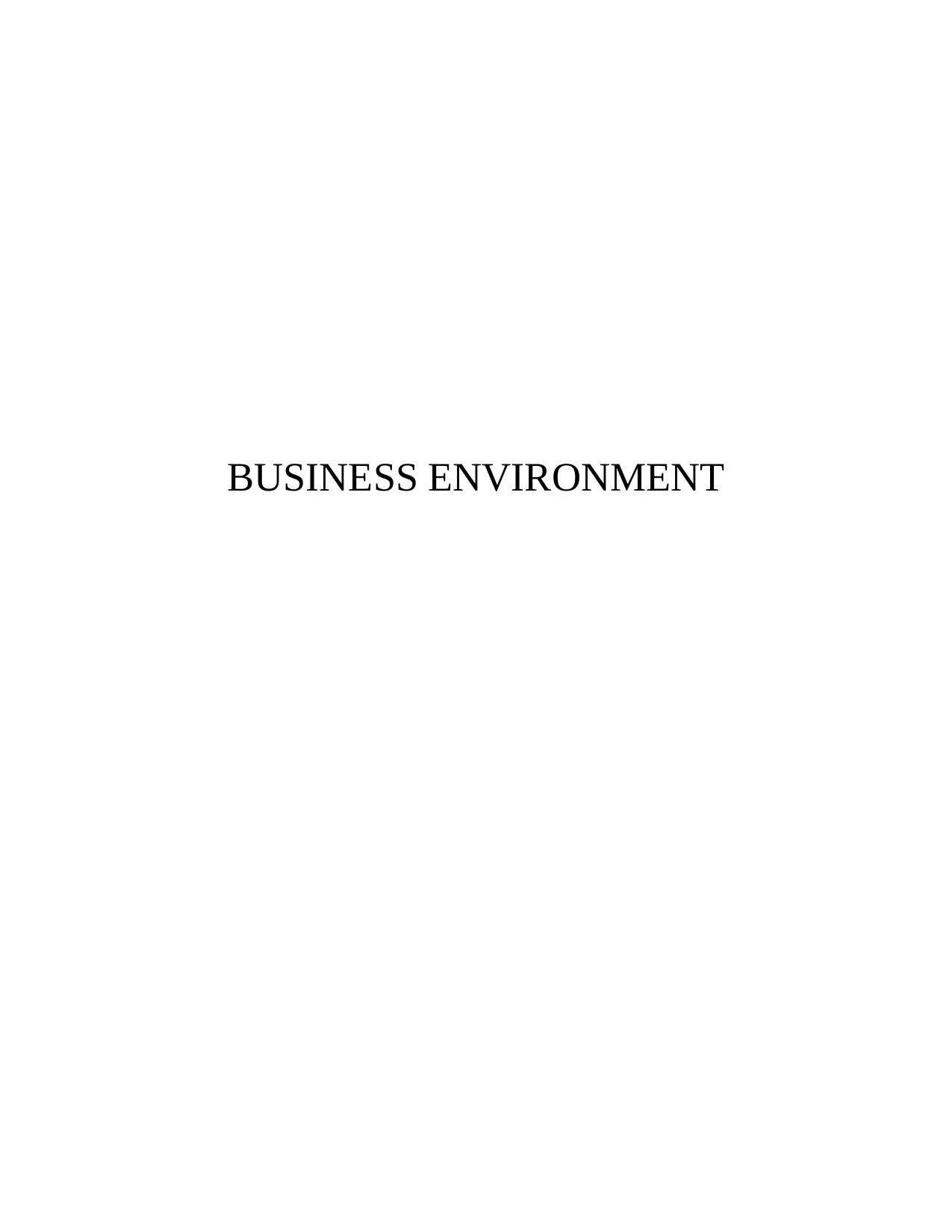
BUSINESS ENVIRONMENT
Paraphrase This Document
Need a fresh take? Get an instant paraphrase of this document with our AI Paraphraser
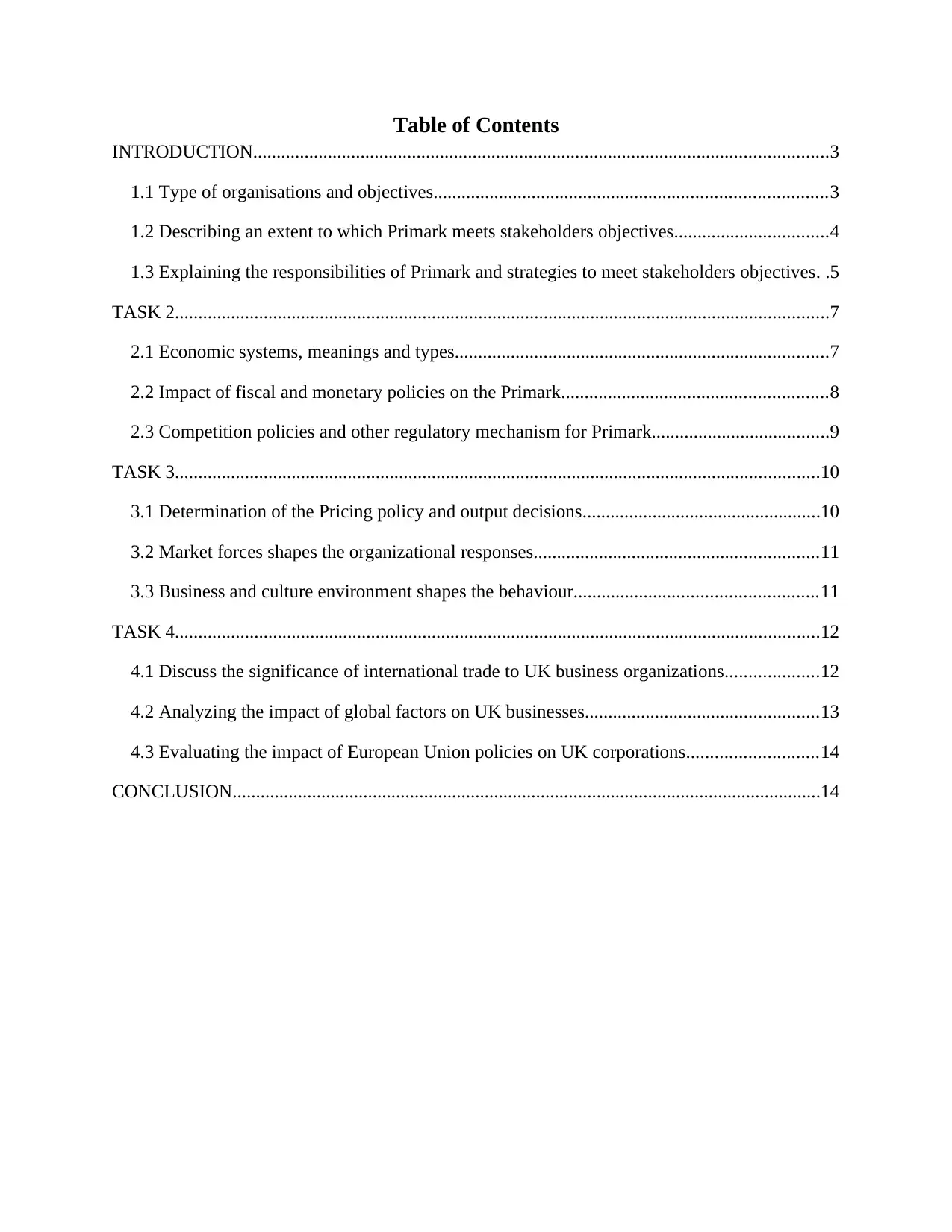
Table of Contents
INTRODUCTION...........................................................................................................................3
1.1 Type of organisations and objectives....................................................................................3
1.2 Describing an extent to which Primark meets stakeholders objectives.................................4
1.3 Explaining the responsibilities of Primark and strategies to meet stakeholders objectives. .5
TASK 2............................................................................................................................................7
2.1 Economic systems, meanings and types................................................................................7
2.2 Impact of fiscal and monetary policies on the Primark.........................................................8
2.3 Competition policies and other regulatory mechanism for Primark......................................9
TASK 3..........................................................................................................................................10
3.1 Determination of the Pricing policy and output decisions...................................................10
3.2 Market forces shapes the organizational responses.............................................................11
3.3 Business and culture environment shapes the behaviour....................................................11
TASK 4..........................................................................................................................................12
4.1 Discuss the significance of international trade to UK business organizations....................12
4.2 Analyzing the impact of global factors on UK businesses..................................................13
4.3 Evaluating the impact of European Union policies on UK corporations............................14
CONCLUSION..............................................................................................................................14
INTRODUCTION...........................................................................................................................3
1.1 Type of organisations and objectives....................................................................................3
1.2 Describing an extent to which Primark meets stakeholders objectives.................................4
1.3 Explaining the responsibilities of Primark and strategies to meet stakeholders objectives. .5
TASK 2............................................................................................................................................7
2.1 Economic systems, meanings and types................................................................................7
2.2 Impact of fiscal and monetary policies on the Primark.........................................................8
2.3 Competition policies and other regulatory mechanism for Primark......................................9
TASK 3..........................................................................................................................................10
3.1 Determination of the Pricing policy and output decisions...................................................10
3.2 Market forces shapes the organizational responses.............................................................11
3.3 Business and culture environment shapes the behaviour....................................................11
TASK 4..........................................................................................................................................12
4.1 Discuss the significance of international trade to UK business organizations....................12
4.2 Analyzing the impact of global factors on UK businesses..................................................13
4.3 Evaluating the impact of European Union policies on UK corporations............................14
CONCLUSION..............................................................................................................................14
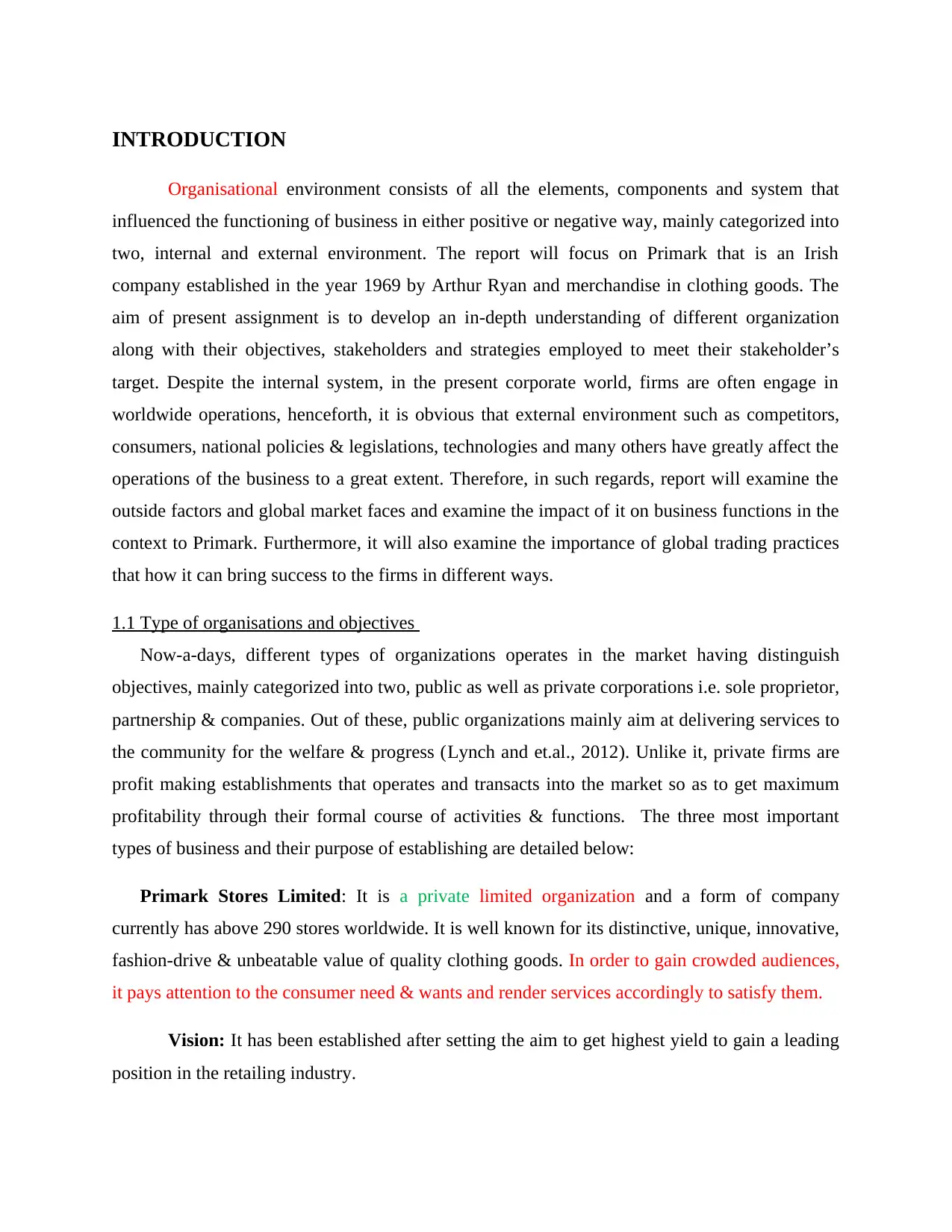
INTRODUCTION
Organisational environment consists of all the elements, components and system that
influenced the functioning of business in either positive or negative way, mainly categorized into
two, internal and external environment. The report will focus on Primark that is an Irish
company established in the year 1969 by Arthur Ryan and merchandise in clothing goods. The
aim of present assignment is to develop an in-depth understanding of different organization
along with their objectives, stakeholders and strategies employed to meet their stakeholder’s
target. Despite the internal system, in the present corporate world, firms are often engage in
worldwide operations, henceforth, it is obvious that external environment such as competitors,
consumers, national policies & legislations, technologies and many others have greatly affect the
operations of the business to a great extent. Therefore, in such regards, report will examine the
outside factors and global market faces and examine the impact of it on business functions in the
context to Primark. Furthermore, it will also examine the importance of global trading practices
that how it can bring success to the firms in different ways.
1.1 Type of organisations and objectives
Now-a-days, different types of organizations operates in the market having distinguish
objectives, mainly categorized into two, public as well as private corporations i.e. sole proprietor,
partnership & companies. Out of these, public organizations mainly aim at delivering services to
the community for the welfare & progress (Lynch and et.al., 2012). Unlike it, private firms are
profit making establishments that operates and transacts into the market so as to get maximum
profitability through their formal course of activities & functions. The three most important
types of business and their purpose of establishing are detailed below:
Primark Stores Limited: It is a private limited organization and a form of company
currently has above 290 stores worldwide. It is well known for its distinctive, unique, innovative,
fashion-drive & unbeatable value of quality clothing goods. In order to gain crowded audiences,
it pays attention to the consumer need & wants and render services accordingly to satisfy them.
Vision: It has been established after setting the aim to get highest yield to gain a leading
position in the retailing industry.
Organisational environment consists of all the elements, components and system that
influenced the functioning of business in either positive or negative way, mainly categorized into
two, internal and external environment. The report will focus on Primark that is an Irish
company established in the year 1969 by Arthur Ryan and merchandise in clothing goods. The
aim of present assignment is to develop an in-depth understanding of different organization
along with their objectives, stakeholders and strategies employed to meet their stakeholder’s
target. Despite the internal system, in the present corporate world, firms are often engage in
worldwide operations, henceforth, it is obvious that external environment such as competitors,
consumers, national policies & legislations, technologies and many others have greatly affect the
operations of the business to a great extent. Therefore, in such regards, report will examine the
outside factors and global market faces and examine the impact of it on business functions in the
context to Primark. Furthermore, it will also examine the importance of global trading practices
that how it can bring success to the firms in different ways.
1.1 Type of organisations and objectives
Now-a-days, different types of organizations operates in the market having distinguish
objectives, mainly categorized into two, public as well as private corporations i.e. sole proprietor,
partnership & companies. Out of these, public organizations mainly aim at delivering services to
the community for the welfare & progress (Lynch and et.al., 2012). Unlike it, private firms are
profit making establishments that operates and transacts into the market so as to get maximum
profitability through their formal course of activities & functions. The three most important
types of business and their purpose of establishing are detailed below:
Primark Stores Limited: It is a private limited organization and a form of company
currently has above 290 stores worldwide. It is well known for its distinctive, unique, innovative,
fashion-drive & unbeatable value of quality clothing goods. In order to gain crowded audiences,
it pays attention to the consumer need & wants and render services accordingly to satisfy them.
Vision: It has been established after setting the aim to get highest yield to gain a leading
position in the retailing industry.
⊘ This is a preview!⊘
Do you want full access?
Subscribe today to unlock all pages.

Trusted by 1+ million students worldwide
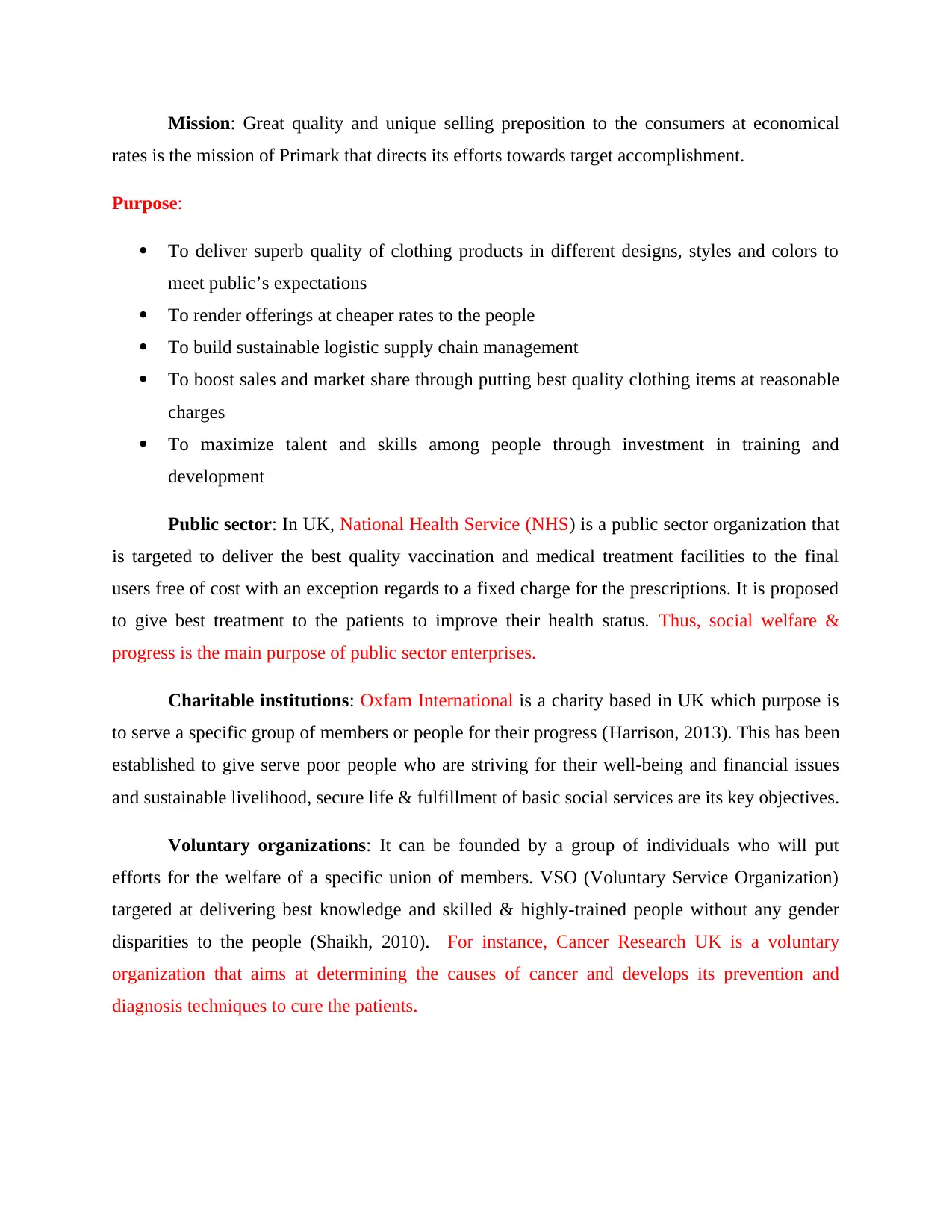
Mission: Great quality and unique selling preposition to the consumers at economical
rates is the mission of Primark that directs its efforts towards target accomplishment.
Purpose:
To deliver superb quality of clothing products in different designs, styles and colors to
meet public’s expectations
To render offerings at cheaper rates to the people
To build sustainable logistic supply chain management
To boost sales and market share through putting best quality clothing items at reasonable
charges
To maximize talent and skills among people through investment in training and
development
Public sector: In UK, National Health Service (NHS) is a public sector organization that
is targeted to deliver the best quality vaccination and medical treatment facilities to the final
users free of cost with an exception regards to a fixed charge for the prescriptions. It is proposed
to give best treatment to the patients to improve their health status. Thus, social welfare &
progress is the main purpose of public sector enterprises.
Charitable institutions: Oxfam International is a charity based in UK which purpose is
to serve a specific group of members or people for their progress (Harrison, 2013). This has been
established to give serve poor people who are striving for their well-being and financial issues
and sustainable livelihood, secure life & fulfillment of basic social services are its key objectives.
Voluntary organizations: It can be founded by a group of individuals who will put
efforts for the welfare of a specific union of members. VSO (Voluntary Service Organization)
targeted at delivering best knowledge and skilled & highly-trained people without any gender
disparities to the people (Shaikh, 2010). For instance, Cancer Research UK is a voluntary
organization that aims at determining the causes of cancer and develops its prevention and
diagnosis techniques to cure the patients.
rates is the mission of Primark that directs its efforts towards target accomplishment.
Purpose:
To deliver superb quality of clothing products in different designs, styles and colors to
meet public’s expectations
To render offerings at cheaper rates to the people
To build sustainable logistic supply chain management
To boost sales and market share through putting best quality clothing items at reasonable
charges
To maximize talent and skills among people through investment in training and
development
Public sector: In UK, National Health Service (NHS) is a public sector organization that
is targeted to deliver the best quality vaccination and medical treatment facilities to the final
users free of cost with an exception regards to a fixed charge for the prescriptions. It is proposed
to give best treatment to the patients to improve their health status. Thus, social welfare &
progress is the main purpose of public sector enterprises.
Charitable institutions: Oxfam International is a charity based in UK which purpose is
to serve a specific group of members or people for their progress (Harrison, 2013). This has been
established to give serve poor people who are striving for their well-being and financial issues
and sustainable livelihood, secure life & fulfillment of basic social services are its key objectives.
Voluntary organizations: It can be founded by a group of individuals who will put
efforts for the welfare of a specific union of members. VSO (Voluntary Service Organization)
targeted at delivering best knowledge and skilled & highly-trained people without any gender
disparities to the people (Shaikh, 2010). For instance, Cancer Research UK is a voluntary
organization that aims at determining the causes of cancer and develops its prevention and
diagnosis techniques to cure the patients.
Paraphrase This Document
Need a fresh take? Get an instant paraphrase of this document with our AI Paraphraser
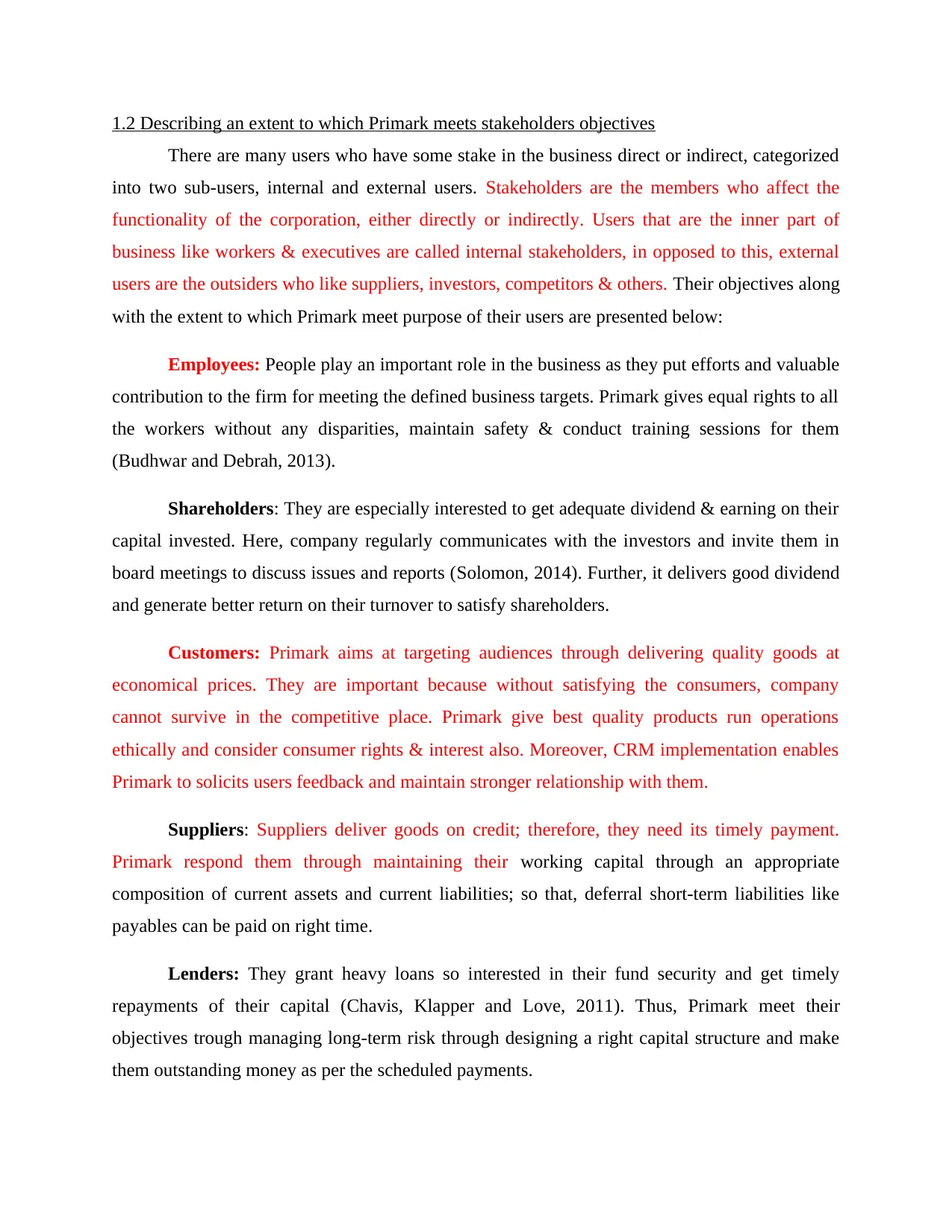
1.2 Describing an extent to which Primark meets stakeholders objectives
There are many users who have some stake in the business direct or indirect, categorized
into two sub-users, internal and external users. Stakeholders are the members who affect the
functionality of the corporation, either directly or indirectly. Users that are the inner part of
business like workers & executives are called internal stakeholders, in opposed to this, external
users are the outsiders who like suppliers, investors, competitors & others. Their objectives along
with the extent to which Primark meet purpose of their users are presented below:
Employees: People play an important role in the business as they put efforts and valuable
contribution to the firm for meeting the defined business targets. Primark gives equal rights to all
the workers without any disparities, maintain safety & conduct training sessions for them
(Budhwar and Debrah, 2013).
Shareholders: They are especially interested to get adequate dividend & earning on their
capital invested. Here, company regularly communicates with the investors and invite them in
board meetings to discuss issues and reports (Solomon, 2014). Further, it delivers good dividend
and generate better return on their turnover to satisfy shareholders.
Customers: Primark aims at targeting audiences through delivering quality goods at
economical prices. They are important because without satisfying the consumers, company
cannot survive in the competitive place. Primark give best quality products run operations
ethically and consider consumer rights & interest also. Moreover, CRM implementation enables
Primark to solicits users feedback and maintain stronger relationship with them.
Suppliers: Suppliers deliver goods on credit; therefore, they need its timely payment.
Primark respond them through maintaining their working capital through an appropriate
composition of current assets and current liabilities; so that, deferral short-term liabilities like
payables can be paid on right time.
Lenders: They grant heavy loans so interested in their fund security and get timely
repayments of their capital (Chavis, Klapper and Love, 2011). Thus, Primark meet their
objectives trough managing long-term risk through designing a right capital structure and make
them outstanding money as per the scheduled payments.
There are many users who have some stake in the business direct or indirect, categorized
into two sub-users, internal and external users. Stakeholders are the members who affect the
functionality of the corporation, either directly or indirectly. Users that are the inner part of
business like workers & executives are called internal stakeholders, in opposed to this, external
users are the outsiders who like suppliers, investors, competitors & others. Their objectives along
with the extent to which Primark meet purpose of their users are presented below:
Employees: People play an important role in the business as they put efforts and valuable
contribution to the firm for meeting the defined business targets. Primark gives equal rights to all
the workers without any disparities, maintain safety & conduct training sessions for them
(Budhwar and Debrah, 2013).
Shareholders: They are especially interested to get adequate dividend & earning on their
capital invested. Here, company regularly communicates with the investors and invite them in
board meetings to discuss issues and reports (Solomon, 2014). Further, it delivers good dividend
and generate better return on their turnover to satisfy shareholders.
Customers: Primark aims at targeting audiences through delivering quality goods at
economical prices. They are important because without satisfying the consumers, company
cannot survive in the competitive place. Primark give best quality products run operations
ethically and consider consumer rights & interest also. Moreover, CRM implementation enables
Primark to solicits users feedback and maintain stronger relationship with them.
Suppliers: Suppliers deliver goods on credit; therefore, they need its timely payment.
Primark respond them through maintaining their working capital through an appropriate
composition of current assets and current liabilities; so that, deferral short-term liabilities like
payables can be paid on right time.
Lenders: They grant heavy loans so interested in their fund security and get timely
repayments of their capital (Chavis, Klapper and Love, 2011). Thus, Primark meet their
objectives trough managing long-term risk through designing a right capital structure and make
them outstanding money as per the scheduled payments.
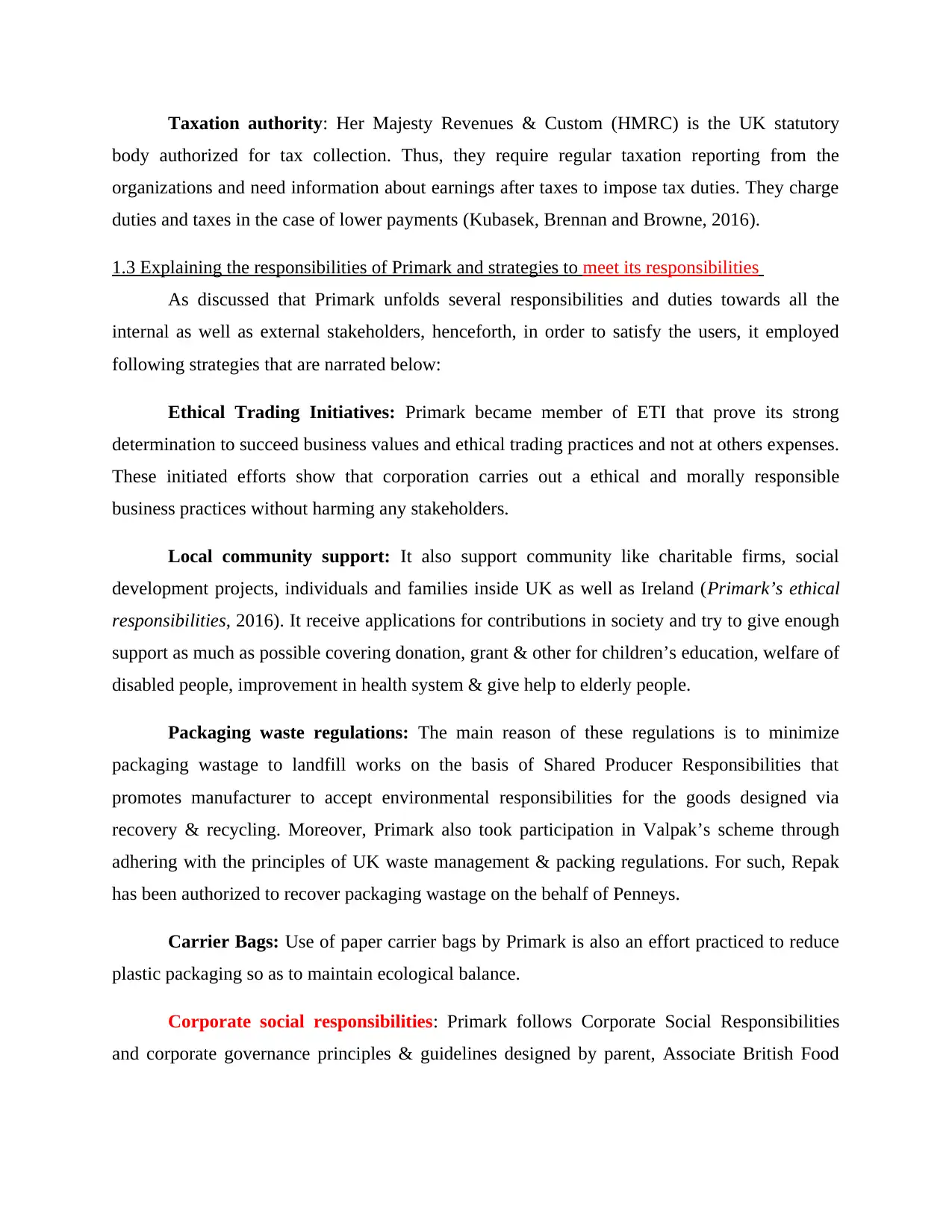
Taxation authority: Her Majesty Revenues & Custom (HMRC) is the UK statutory
body authorized for tax collection. Thus, they require regular taxation reporting from the
organizations and need information about earnings after taxes to impose tax duties. They charge
duties and taxes in the case of lower payments (Kubasek, Brennan and Browne, 2016).
1.3 Explaining the responsibilities of Primark and strategies to meet its responsibilities
As discussed that Primark unfolds several responsibilities and duties towards all the
internal as well as external stakeholders, henceforth, in order to satisfy the users, it employed
following strategies that are narrated below:
Ethical Trading Initiatives: Primark became member of ETI that prove its strong
determination to succeed business values and ethical trading practices and not at others expenses.
These initiated efforts show that corporation carries out a ethical and morally responsible
business practices without harming any stakeholders.
Local community support: It also support community like charitable firms, social
development projects, individuals and families inside UK as well as Ireland (Primark’s ethical
responsibilities, 2016). It receive applications for contributions in society and try to give enough
support as much as possible covering donation, grant & other for children’s education, welfare of
disabled people, improvement in health system & give help to elderly people.
Packaging waste regulations: The main reason of these regulations is to minimize
packaging wastage to landfill works on the basis of Shared Producer Responsibilities that
promotes manufacturer to accept environmental responsibilities for the goods designed via
recovery & recycling. Moreover, Primark also took participation in Valpak’s scheme through
adhering with the principles of UK waste management & packing regulations. For such, Repak
has been authorized to recover packaging wastage on the behalf of Penneys.
Carrier Bags: Use of paper carrier bags by Primark is also an effort practiced to reduce
plastic packaging so as to maintain ecological balance.
Corporate social responsibilities: Primark follows Corporate Social Responsibilities
and corporate governance principles & guidelines designed by parent, Associate British Food
body authorized for tax collection. Thus, they require regular taxation reporting from the
organizations and need information about earnings after taxes to impose tax duties. They charge
duties and taxes in the case of lower payments (Kubasek, Brennan and Browne, 2016).
1.3 Explaining the responsibilities of Primark and strategies to meet its responsibilities
As discussed that Primark unfolds several responsibilities and duties towards all the
internal as well as external stakeholders, henceforth, in order to satisfy the users, it employed
following strategies that are narrated below:
Ethical Trading Initiatives: Primark became member of ETI that prove its strong
determination to succeed business values and ethical trading practices and not at others expenses.
These initiated efforts show that corporation carries out a ethical and morally responsible
business practices without harming any stakeholders.
Local community support: It also support community like charitable firms, social
development projects, individuals and families inside UK as well as Ireland (Primark’s ethical
responsibilities, 2016). It receive applications for contributions in society and try to give enough
support as much as possible covering donation, grant & other for children’s education, welfare of
disabled people, improvement in health system & give help to elderly people.
Packaging waste regulations: The main reason of these regulations is to minimize
packaging wastage to landfill works on the basis of Shared Producer Responsibilities that
promotes manufacturer to accept environmental responsibilities for the goods designed via
recovery & recycling. Moreover, Primark also took participation in Valpak’s scheme through
adhering with the principles of UK waste management & packing regulations. For such, Repak
has been authorized to recover packaging wastage on the behalf of Penneys.
Carrier Bags: Use of paper carrier bags by Primark is also an effort practiced to reduce
plastic packaging so as to maintain ecological balance.
Corporate social responsibilities: Primark follows Corporate Social Responsibilities
and corporate governance principles & guidelines designed by parent, Associate British Food
⊘ This is a preview!⊘
Do you want full access?
Subscribe today to unlock all pages.

Trusted by 1+ million students worldwide
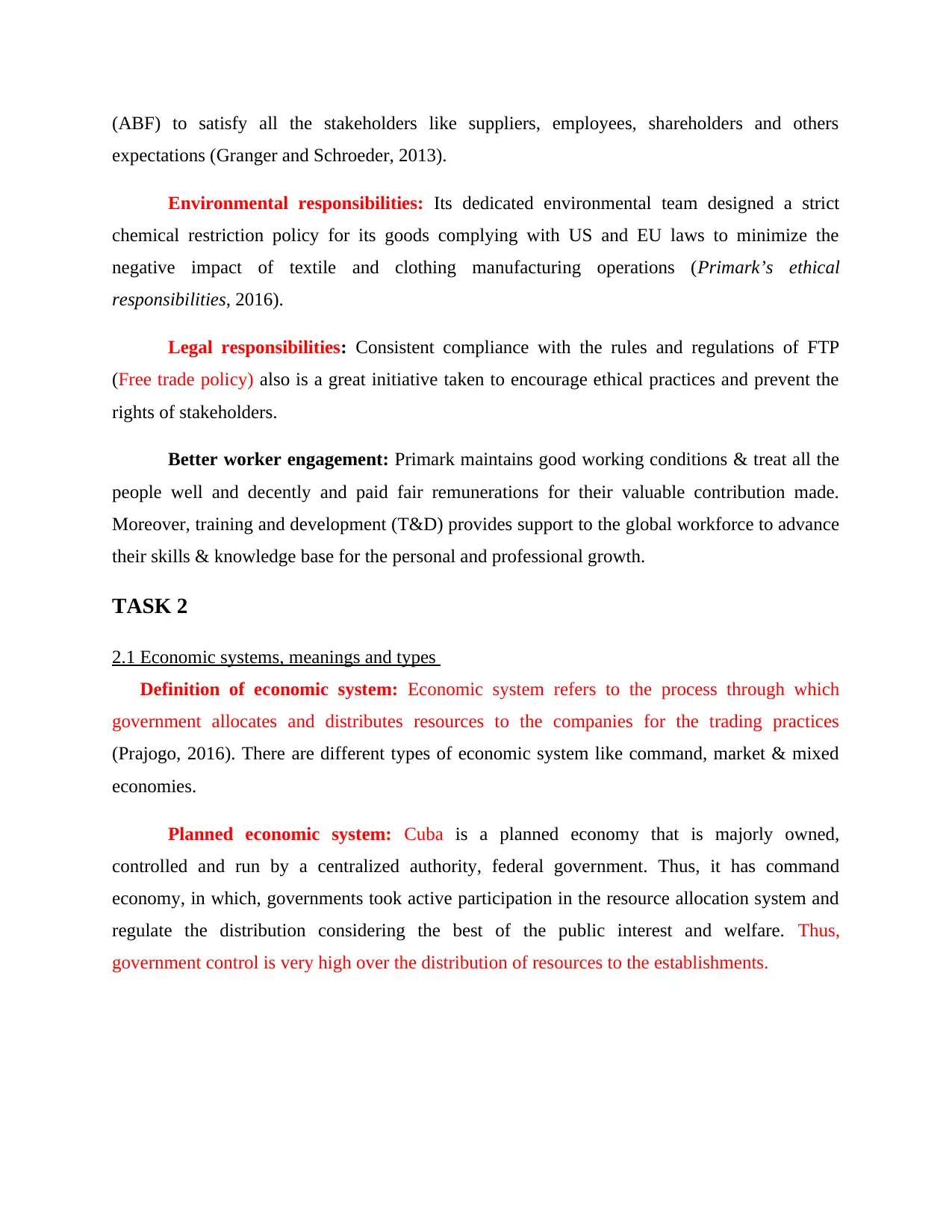
(ABF) to satisfy all the stakeholders like suppliers, employees, shareholders and others
expectations (Granger and Schroeder, 2013).
Environmental responsibilities: Its dedicated environmental team designed a strict
chemical restriction policy for its goods complying with US and EU laws to minimize the
negative impact of textile and clothing manufacturing operations (Primark’s ethical
responsibilities, 2016).
Legal responsibilities: Consistent compliance with the rules and regulations of FTP
(Free trade policy) also is a great initiative taken to encourage ethical practices and prevent the
rights of stakeholders.
Better worker engagement: Primark maintains good working conditions & treat all the
people well and decently and paid fair remunerations for their valuable contribution made.
Moreover, training and development (T&D) provides support to the global workforce to advance
their skills & knowledge base for the personal and professional growth.
TASK 2
2.1 Economic systems, meanings and types
Definition of economic system: Economic system refers to the process through which
government allocates and distributes resources to the companies for the trading practices
(Prajogo, 2016). There are different types of economic system like command, market & mixed
economies.
Planned economic system: Cuba is a planned economy that is majorly owned,
controlled and run by a centralized authority, federal government. Thus, it has command
economy, in which, governments took active participation in the resource allocation system and
regulate the distribution considering the best of the public interest and welfare. Thus,
government control is very high over the distribution of resources to the establishments.
expectations (Granger and Schroeder, 2013).
Environmental responsibilities: Its dedicated environmental team designed a strict
chemical restriction policy for its goods complying with US and EU laws to minimize the
negative impact of textile and clothing manufacturing operations (Primark’s ethical
responsibilities, 2016).
Legal responsibilities: Consistent compliance with the rules and regulations of FTP
(Free trade policy) also is a great initiative taken to encourage ethical practices and prevent the
rights of stakeholders.
Better worker engagement: Primark maintains good working conditions & treat all the
people well and decently and paid fair remunerations for their valuable contribution made.
Moreover, training and development (T&D) provides support to the global workforce to advance
their skills & knowledge base for the personal and professional growth.
TASK 2
2.1 Economic systems, meanings and types
Definition of economic system: Economic system refers to the process through which
government allocates and distributes resources to the companies for the trading practices
(Prajogo, 2016). There are different types of economic system like command, market & mixed
economies.
Planned economic system: Cuba is a planned economy that is majorly owned,
controlled and run by a centralized authority, federal government. Thus, it has command
economy, in which, governments took active participation in the resource allocation system and
regulate the distribution considering the best of the public interest and welfare. Thus,
government control is very high over the distribution of resources to the establishments.
Paraphrase This Document
Need a fresh take? Get an instant paraphrase of this document with our AI Paraphraser
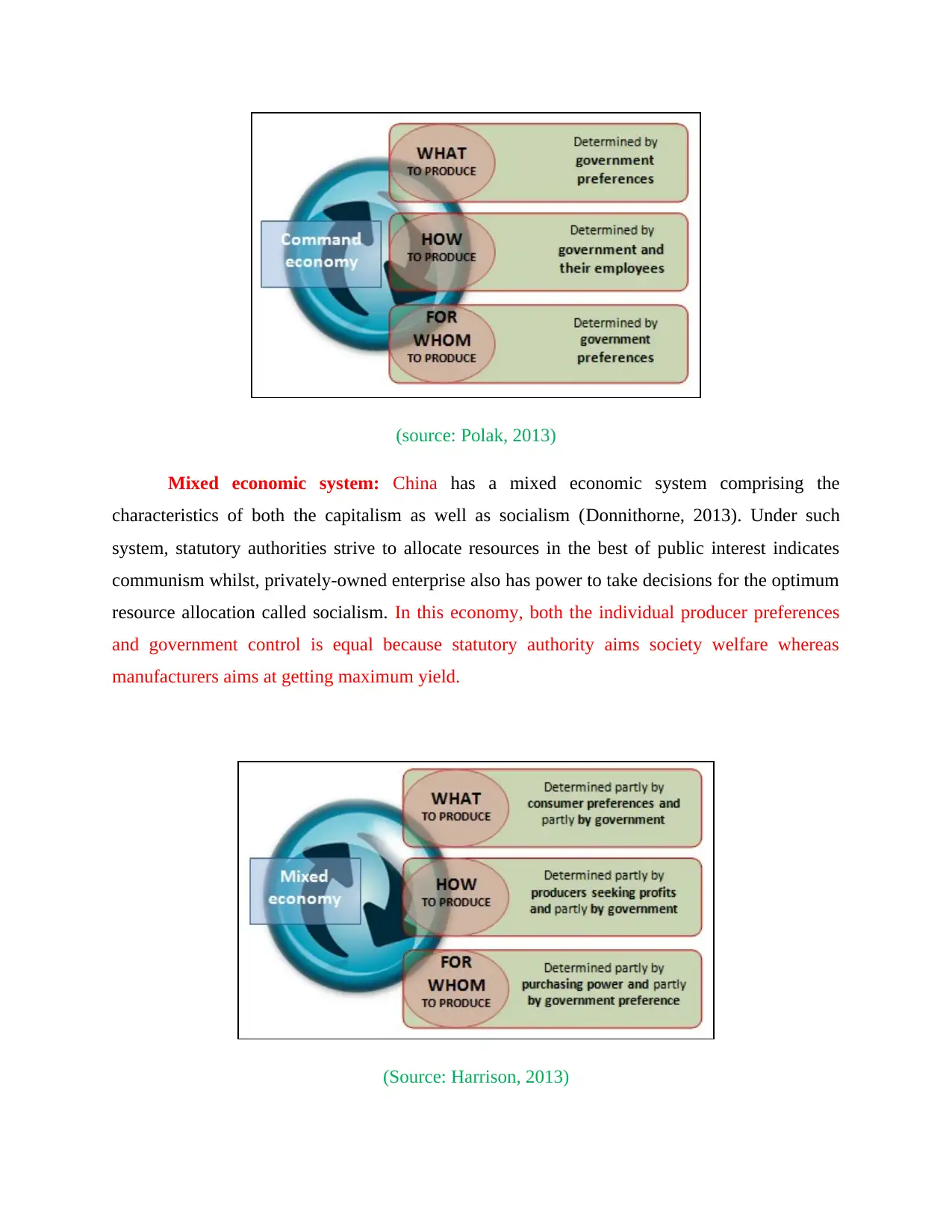
(source: Polak, 2013)
Mixed economic system: China has a mixed economic system comprising the
characteristics of both the capitalism as well as socialism (Donnithorne, 2013). Under such
system, statutory authorities strive to allocate resources in the best of public interest indicates
communism whilst, privately-owned enterprise also has power to take decisions for the optimum
resource allocation called socialism. In this economy, both the individual producer preferences
and government control is equal because statutory authority aims society welfare whereas
manufacturers aims at getting maximum yield.
(Source: Harrison, 2013)
Mixed economic system: China has a mixed economic system comprising the
characteristics of both the capitalism as well as socialism (Donnithorne, 2013). Under such
system, statutory authorities strive to allocate resources in the best of public interest indicates
communism whilst, privately-owned enterprise also has power to take decisions for the optimum
resource allocation called socialism. In this economy, both the individual producer preferences
and government control is equal because statutory authority aims society welfare whereas
manufacturers aims at getting maximum yield.
(Source: Harrison, 2013)
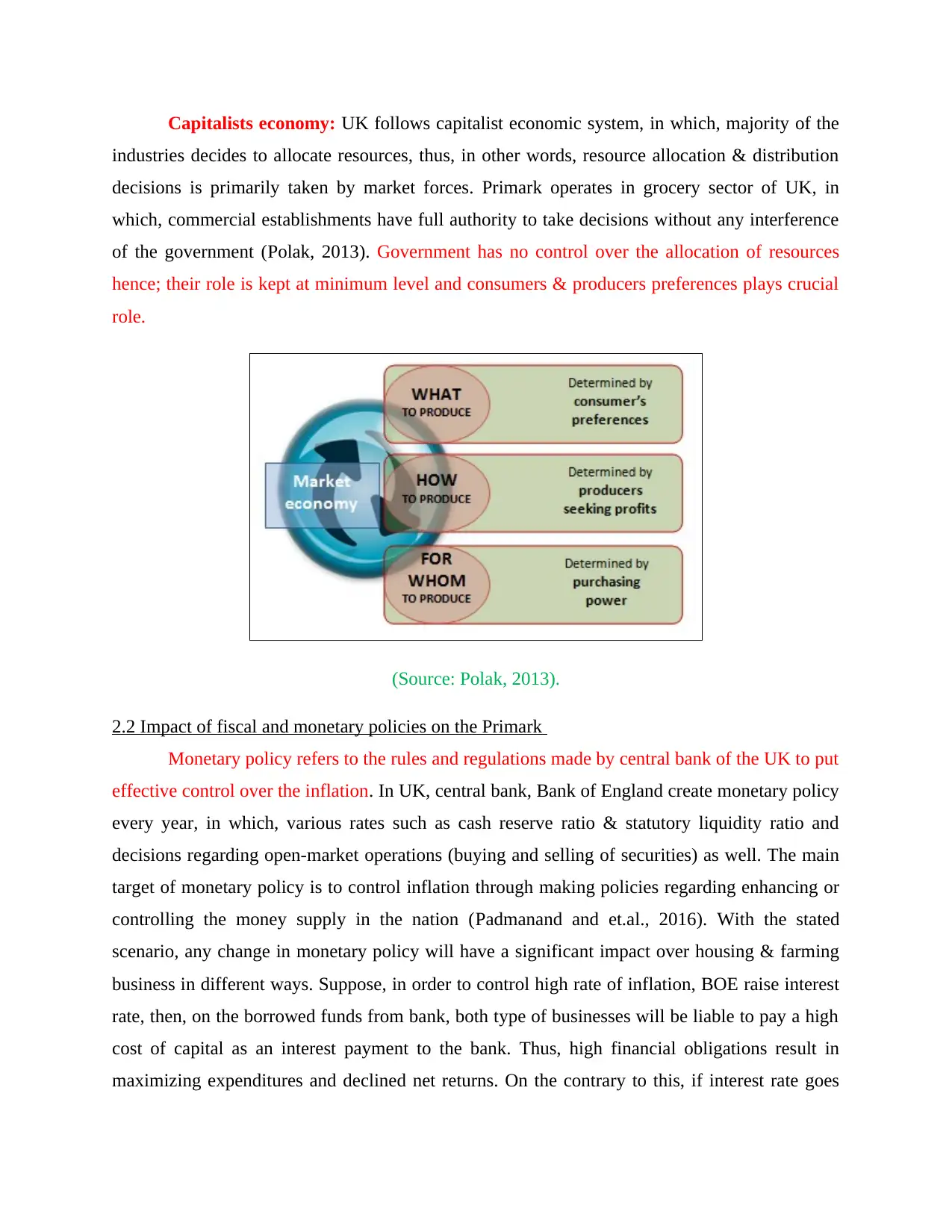
Capitalists economy: UK follows capitalist economic system, in which, majority of the
industries decides to allocate resources, thus, in other words, resource allocation & distribution
decisions is primarily taken by market forces. Primark operates in grocery sector of UK, in
which, commercial establishments have full authority to take decisions without any interference
of the government (Polak, 2013). Government has no control over the allocation of resources
hence; their role is kept at minimum level and consumers & producers preferences plays crucial
role.
(Source: Polak, 2013).
2.2 Impact of fiscal and monetary policies on the Primark
Monetary policy refers to the rules and regulations made by central bank of the UK to put
effective control over the inflation. In UK, central bank, Bank of England create monetary policy
every year, in which, various rates such as cash reserve ratio & statutory liquidity ratio and
decisions regarding open-market operations (buying and selling of securities) as well. The main
target of monetary policy is to control inflation through making policies regarding enhancing or
controlling the money supply in the nation (Padmanand and et.al., 2016). With the stated
scenario, any change in monetary policy will have a significant impact over housing & farming
business in different ways. Suppose, in order to control high rate of inflation, BOE raise interest
rate, then, on the borrowed funds from bank, both type of businesses will be liable to pay a high
cost of capital as an interest payment to the bank. Thus, high financial obligations result in
maximizing expenditures and declined net returns. On the contrary to this, if interest rate goes
industries decides to allocate resources, thus, in other words, resource allocation & distribution
decisions is primarily taken by market forces. Primark operates in grocery sector of UK, in
which, commercial establishments have full authority to take decisions without any interference
of the government (Polak, 2013). Government has no control over the allocation of resources
hence; their role is kept at minimum level and consumers & producers preferences plays crucial
role.
(Source: Polak, 2013).
2.2 Impact of fiscal and monetary policies on the Primark
Monetary policy refers to the rules and regulations made by central bank of the UK to put
effective control over the inflation. In UK, central bank, Bank of England create monetary policy
every year, in which, various rates such as cash reserve ratio & statutory liquidity ratio and
decisions regarding open-market operations (buying and selling of securities) as well. The main
target of monetary policy is to control inflation through making policies regarding enhancing or
controlling the money supply in the nation (Padmanand and et.al., 2016). With the stated
scenario, any change in monetary policy will have a significant impact over housing & farming
business in different ways. Suppose, in order to control high rate of inflation, BOE raise interest
rate, then, on the borrowed funds from bank, both type of businesses will be liable to pay a high
cost of capital as an interest payment to the bank. Thus, high financial obligations result in
maximizing expenditures and declined net returns. On the contrary to this, if interest rate goes
⊘ This is a preview!⊘
Do you want full access?
Subscribe today to unlock all pages.

Trusted by 1+ million students worldwide
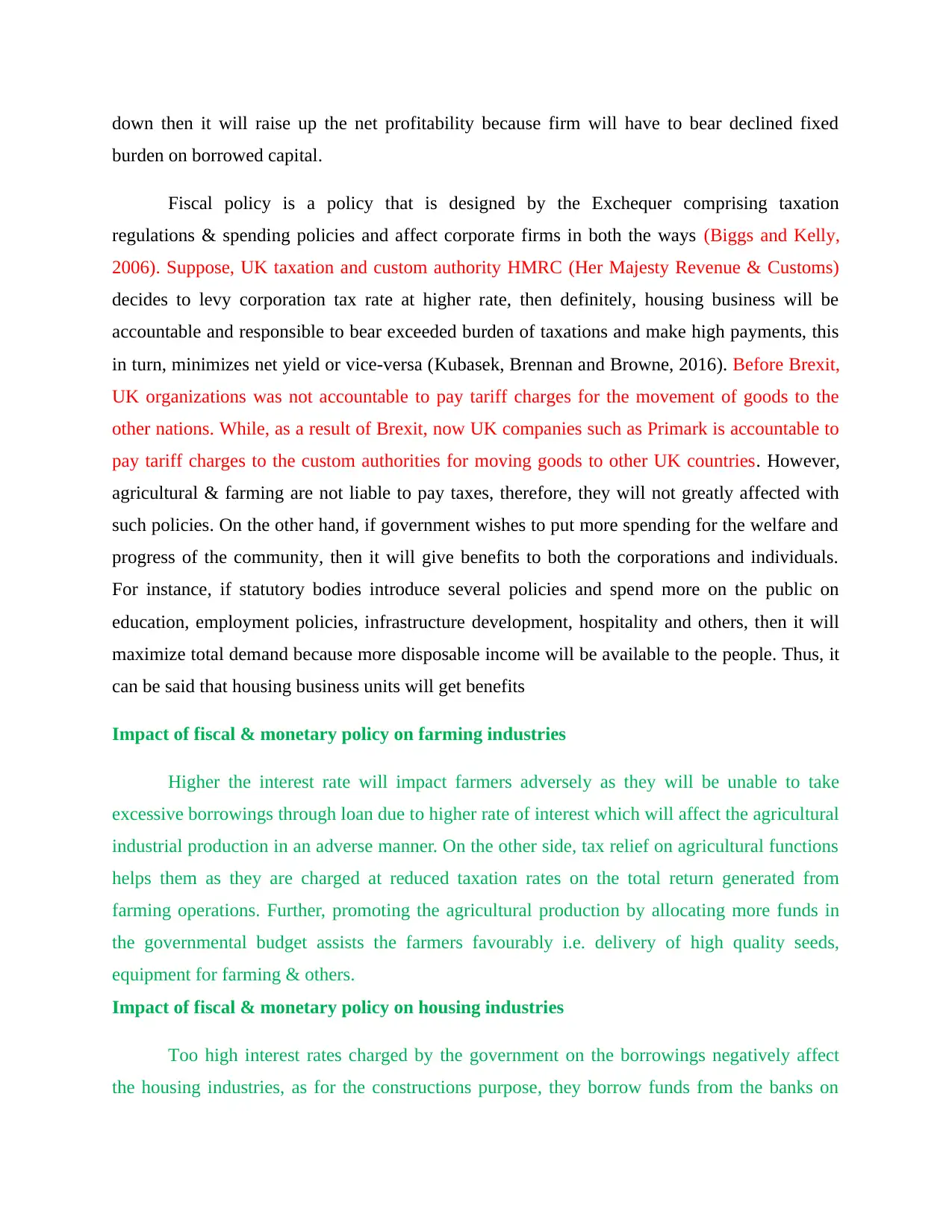
down then it will raise up the net profitability because firm will have to bear declined fixed
burden on borrowed capital.
Fiscal policy is a policy that is designed by the Exchequer comprising taxation
regulations & spending policies and affect corporate firms in both the ways (Biggs and Kelly,
2006). Suppose, UK taxation and custom authority HMRC (Her Majesty Revenue & Customs)
decides to levy corporation tax rate at higher rate, then definitely, housing business will be
accountable and responsible to bear exceeded burden of taxations and make high payments, this
in turn, minimizes net yield or vice-versa (Kubasek, Brennan and Browne, 2016). Before Brexit,
UK organizations was not accountable to pay tariff charges for the movement of goods to the
other nations. While, as a result of Brexit, now UK companies such as Primark is accountable to
pay tariff charges to the custom authorities for moving goods to other UK countries. However,
agricultural & farming are not liable to pay taxes, therefore, they will not greatly affected with
such policies. On the other hand, if government wishes to put more spending for the welfare and
progress of the community, then it will give benefits to both the corporations and individuals.
For instance, if statutory bodies introduce several policies and spend more on the public on
education, employment policies, infrastructure development, hospitality and others, then it will
maximize total demand because more disposable income will be available to the people. Thus, it
can be said that housing business units will get benefits
Impact of fiscal & monetary policy on farming industries
Higher the interest rate will impact farmers adversely as they will be unable to take
excessive borrowings through loan due to higher rate of interest which will affect the agricultural
industrial production in an adverse manner. On the other side, tax relief on agricultural functions
helps them as they are charged at reduced taxation rates on the total return generated from
farming operations. Further, promoting the agricultural production by allocating more funds in
the governmental budget assists the farmers favourably i.e. delivery of high quality seeds,
equipment for farming & others.
Impact of fiscal & monetary policy on housing industries
Too high interest rates charged by the government on the borrowings negatively affect
the housing industries, as for the constructions purpose, they borrow funds from the banks on
burden on borrowed capital.
Fiscal policy is a policy that is designed by the Exchequer comprising taxation
regulations & spending policies and affect corporate firms in both the ways (Biggs and Kelly,
2006). Suppose, UK taxation and custom authority HMRC (Her Majesty Revenue & Customs)
decides to levy corporation tax rate at higher rate, then definitely, housing business will be
accountable and responsible to bear exceeded burden of taxations and make high payments, this
in turn, minimizes net yield or vice-versa (Kubasek, Brennan and Browne, 2016). Before Brexit,
UK organizations was not accountable to pay tariff charges for the movement of goods to the
other nations. While, as a result of Brexit, now UK companies such as Primark is accountable to
pay tariff charges to the custom authorities for moving goods to other UK countries. However,
agricultural & farming are not liable to pay taxes, therefore, they will not greatly affected with
such policies. On the other hand, if government wishes to put more spending for the welfare and
progress of the community, then it will give benefits to both the corporations and individuals.
For instance, if statutory bodies introduce several policies and spend more on the public on
education, employment policies, infrastructure development, hospitality and others, then it will
maximize total demand because more disposable income will be available to the people. Thus, it
can be said that housing business units will get benefits
Impact of fiscal & monetary policy on farming industries
Higher the interest rate will impact farmers adversely as they will be unable to take
excessive borrowings through loan due to higher rate of interest which will affect the agricultural
industrial production in an adverse manner. On the other side, tax relief on agricultural functions
helps them as they are charged at reduced taxation rates on the total return generated from
farming operations. Further, promoting the agricultural production by allocating more funds in
the governmental budget assists the farmers favourably i.e. delivery of high quality seeds,
equipment for farming & others.
Impact of fiscal & monetary policy on housing industries
Too high interest rates charged by the government on the borrowings negatively affect
the housing industries, as for the constructions purpose, they borrow funds from the banks on
Paraphrase This Document
Need a fresh take? Get an instant paraphrase of this document with our AI Paraphraser
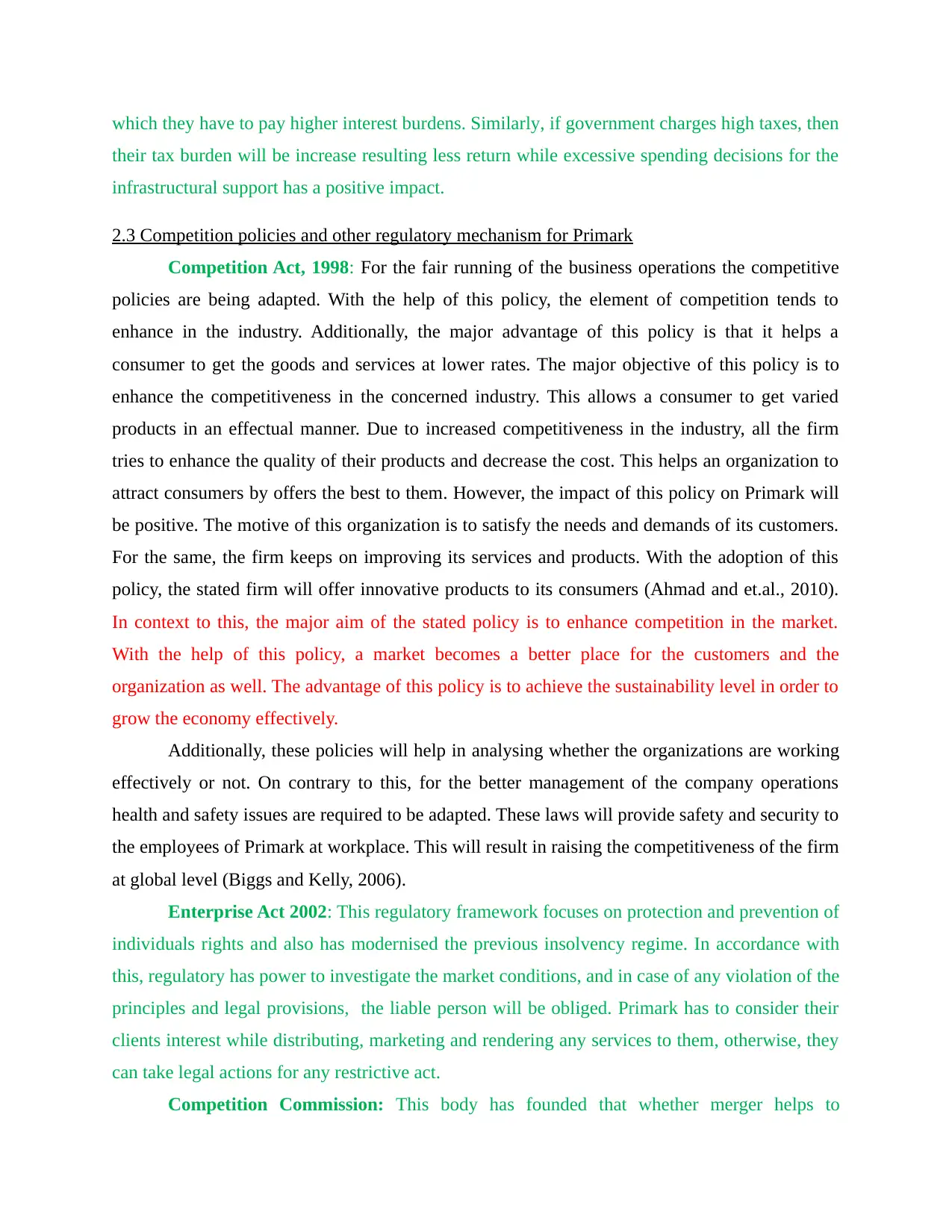
which they have to pay higher interest burdens. Similarly, if government charges high taxes, then
their tax burden will be increase resulting less return while excessive spending decisions for the
infrastructural support has a positive impact.
2.3 Competition policies and other regulatory mechanism for Primark
Competition Act, 1998: For the fair running of the business operations the competitive
policies are being adapted. With the help of this policy, the element of competition tends to
enhance in the industry. Additionally, the major advantage of this policy is that it helps a
consumer to get the goods and services at lower rates. The major objective of this policy is to
enhance the competitiveness in the concerned industry. This allows a consumer to get varied
products in an effectual manner. Due to increased competitiveness in the industry, all the firm
tries to enhance the quality of their products and decrease the cost. This helps an organization to
attract consumers by offers the best to them. However, the impact of this policy on Primark will
be positive. The motive of this organization is to satisfy the needs and demands of its customers.
For the same, the firm keeps on improving its services and products. With the adoption of this
policy, the stated firm will offer innovative products to its consumers (Ahmad and et.al., 2010).
In context to this, the major aim of the stated policy is to enhance competition in the market.
With the help of this policy, a market becomes a better place for the customers and the
organization as well. The advantage of this policy is to achieve the sustainability level in order to
grow the economy effectively.
Additionally, these policies will help in analysing whether the organizations are working
effectively or not. On contrary to this, for the better management of the company operations
health and safety issues are required to be adapted. These laws will provide safety and security to
the employees of Primark at workplace. This will result in raising the competitiveness of the firm
at global level (Biggs and Kelly, 2006).
Enterprise Act 2002: This regulatory framework focuses on protection and prevention of
individuals rights and also has modernised the previous insolvency regime. In accordance with
this, regulatory has power to investigate the market conditions, and in case of any violation of the
principles and legal provisions, the liable person will be obliged. Primark has to consider their
clients interest while distributing, marketing and rendering any services to them, otherwise, they
can take legal actions for any restrictive act.
Competition Commission: This body has founded that whether merger helps to
their tax burden will be increase resulting less return while excessive spending decisions for the
infrastructural support has a positive impact.
2.3 Competition policies and other regulatory mechanism for Primark
Competition Act, 1998: For the fair running of the business operations the competitive
policies are being adapted. With the help of this policy, the element of competition tends to
enhance in the industry. Additionally, the major advantage of this policy is that it helps a
consumer to get the goods and services at lower rates. The major objective of this policy is to
enhance the competitiveness in the concerned industry. This allows a consumer to get varied
products in an effectual manner. Due to increased competitiveness in the industry, all the firm
tries to enhance the quality of their products and decrease the cost. This helps an organization to
attract consumers by offers the best to them. However, the impact of this policy on Primark will
be positive. The motive of this organization is to satisfy the needs and demands of its customers.
For the same, the firm keeps on improving its services and products. With the adoption of this
policy, the stated firm will offer innovative products to its consumers (Ahmad and et.al., 2010).
In context to this, the major aim of the stated policy is to enhance competition in the market.
With the help of this policy, a market becomes a better place for the customers and the
organization as well. The advantage of this policy is to achieve the sustainability level in order to
grow the economy effectively.
Additionally, these policies will help in analysing whether the organizations are working
effectively or not. On contrary to this, for the better management of the company operations
health and safety issues are required to be adapted. These laws will provide safety and security to
the employees of Primark at workplace. This will result in raising the competitiveness of the firm
at global level (Biggs and Kelly, 2006).
Enterprise Act 2002: This regulatory framework focuses on protection and prevention of
individuals rights and also has modernised the previous insolvency regime. In accordance with
this, regulatory has power to investigate the market conditions, and in case of any violation of the
principles and legal provisions, the liable person will be obliged. Primark has to consider their
clients interest while distributing, marketing and rendering any services to them, otherwise, they
can take legal actions for any restrictive act.
Competition Commission: This body has founded that whether merger helps to
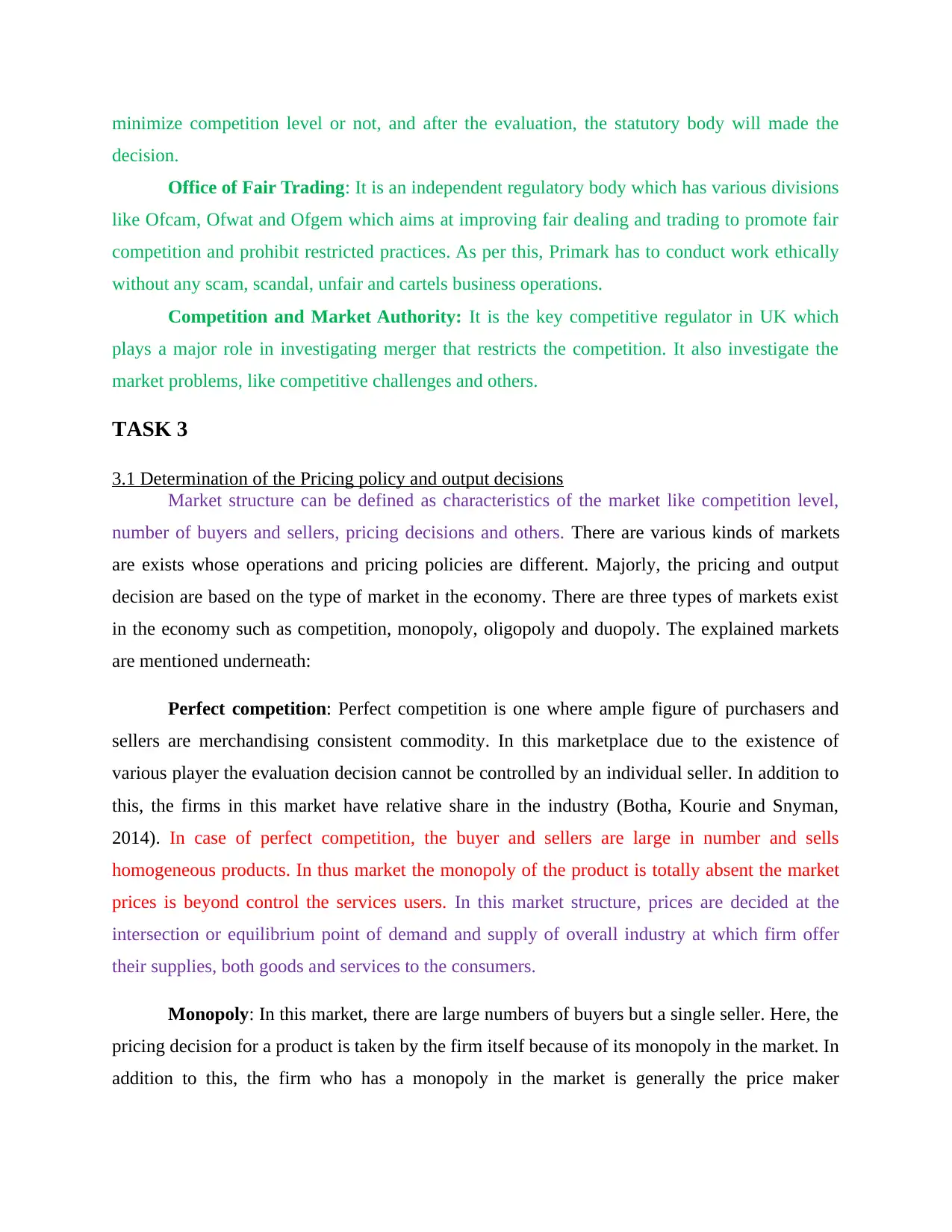
minimize competition level or not, and after the evaluation, the statutory body will made the
decision.
Office of Fair Trading: It is an independent regulatory body which has various divisions
like Ofcam, Ofwat and Ofgem which aims at improving fair dealing and trading to promote fair
competition and prohibit restricted practices. As per this, Primark has to conduct work ethically
without any scam, scandal, unfair and cartels business operations.
Competition and Market Authority: It is the key competitive regulator in UK which
plays a major role in investigating merger that restricts the competition. It also investigate the
market problems, like competitive challenges and others.
TASK 3
3.1 Determination of the Pricing policy and output decisions
Market structure can be defined as characteristics of the market like competition level,
number of buyers and sellers, pricing decisions and others. There are various kinds of markets
are exists whose operations and pricing policies are different. Majorly, the pricing and output
decision are based on the type of market in the economy. There are three types of markets exist
in the economy such as competition, monopoly, oligopoly and duopoly. The explained markets
are mentioned underneath:
Perfect competition: Perfect competition is one where ample figure of purchasers and
sellers are merchandising consistent commodity. In this marketplace due to the existence of
various player the evaluation decision cannot be controlled by an individual seller. In addition to
this, the firms in this market have relative share in the industry (Botha, Kourie and Snyman,
2014). In case of perfect competition, the buyer and sellers are large in number and sells
homogeneous products. In thus market the monopoly of the product is totally absent the market
prices is beyond control the services users. In this market structure, prices are decided at the
intersection or equilibrium point of demand and supply of overall industry at which firm offer
their supplies, both goods and services to the consumers.
Monopoly: In this market, there are large numbers of buyers but a single seller. Here, the
pricing decision for a product is taken by the firm itself because of its monopoly in the market. In
addition to this, the firm who has a monopoly in the market is generally the price maker
decision.
Office of Fair Trading: It is an independent regulatory body which has various divisions
like Ofcam, Ofwat and Ofgem which aims at improving fair dealing and trading to promote fair
competition and prohibit restricted practices. As per this, Primark has to conduct work ethically
without any scam, scandal, unfair and cartels business operations.
Competition and Market Authority: It is the key competitive regulator in UK which
plays a major role in investigating merger that restricts the competition. It also investigate the
market problems, like competitive challenges and others.
TASK 3
3.1 Determination of the Pricing policy and output decisions
Market structure can be defined as characteristics of the market like competition level,
number of buyers and sellers, pricing decisions and others. There are various kinds of markets
are exists whose operations and pricing policies are different. Majorly, the pricing and output
decision are based on the type of market in the economy. There are three types of markets exist
in the economy such as competition, monopoly, oligopoly and duopoly. The explained markets
are mentioned underneath:
Perfect competition: Perfect competition is one where ample figure of purchasers and
sellers are merchandising consistent commodity. In this marketplace due to the existence of
various player the evaluation decision cannot be controlled by an individual seller. In addition to
this, the firms in this market have relative share in the industry (Botha, Kourie and Snyman,
2014). In case of perfect competition, the buyer and sellers are large in number and sells
homogeneous products. In thus market the monopoly of the product is totally absent the market
prices is beyond control the services users. In this market structure, prices are decided at the
intersection or equilibrium point of demand and supply of overall industry at which firm offer
their supplies, both goods and services to the consumers.
Monopoly: In this market, there are large numbers of buyers but a single seller. Here, the
pricing decision for a product is taken by the firm itself because of its monopoly in the market. In
addition to this, the firm who has a monopoly in the market is generally the price maker
⊘ This is a preview!⊘
Do you want full access?
Subscribe today to unlock all pages.

Trusted by 1+ million students worldwide
1 out of 24
Related Documents
Your All-in-One AI-Powered Toolkit for Academic Success.
+13062052269
info@desklib.com
Available 24*7 on WhatsApp / Email
![[object Object]](/_next/static/media/star-bottom.7253800d.svg)
Unlock your academic potential
Copyright © 2020–2025 A2Z Services. All Rights Reserved. Developed and managed by ZUCOL.





